Vol.
33 No. 3
May-June 2011
by Robert W. Slater
This article explores how critical events can be turning points in defining policy agendas for both the private and public sectors and for civil society. First, the article describes the general way that licenses to operate are awarded to enterprises. Then it examines why a significant operational failure—a crisis—gets so much attention and how short- and long-term changes emerge from the wreckage. The Bhopal and Gulf BP incidents are used as case studies.
There are three types of licenses under which companies operate:
Commercial License: Does the project meet the goal for return on investment for the shareholders? Does it meet the requirements of investors? Is it financially sound over its expected lifespan?
Government License: Does the project comply with all applicable laws and regulations—from local to global? Has it complied with due administrative process?
Public License: This exists when the public trusts a company in terms of its products, operations, and management. When trust has been established the company’s products are welcomed in the marketplace, their plants are welcomed in communities, and they can attract high-quality personnel to work for them. Some have described this as socially generated economic capital, others have called it goodwill. When trust is lost, nothing can be taken for granted. This socially approved license is not formal or well documented, but it is just as important and real as the others.
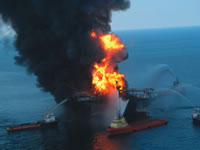 |
| The Deepwater Horizon drilling platform on fire. Photo: U.S. Coast Guard. |
Debates over the public licence to operate, after commercial and governance licences have already been granted, are quite common. For example, a boycott on Canadian pulp and paper products that occurred in Germany for a period in the 1990s was a protest against clear cutting of old-growth forests. A current attempt to deter tourists from visiting Alberta is associated with the environmental consequences of exploiting the oil sands.
Campaigns in favor of a public license can also be found. A current example is the breakthrough Boreal Forest Conservation agreement recently signed between the Canadian Forest Industry and environmental groups. With the agreement, which applies to an area twice the size of Germany, the industry has committed to meeting the world’s highest standards in forest management and environmental groups agreed to suspend their “do not buy” campaign while the agreement is implemented. The agreement took 20 years to
establish.
Events that attract public attention, especially photogenic ones, precipitate change and influence the terms of all of the three licenses mentioned above. A project mired in controversy because of environmental or human health concerns will find it more difficult to attract investors. When investors are found, there may well be a premium to pay on the interest for loans and charges for insurance because the investment is considered more risky. This can have a spill-over effect and move from a single company to embroil an entire sector. This can be nationally and internationally significant—as is the case with the Canadian oil sands.
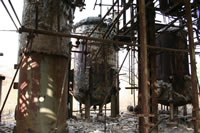 |
| The infamous Union Carbide plant in Bhopal, India. |
Public concerns can register with politicians and can be translated into a demand “to do something” visible and understandable that will impress and assure the general public. The search for the guilty party and their punishment may be pursued and regulations developed with the aim of avoiding a repetition. “React and cure” decisions taken in the white-hot crucible of public controversy are reasonably straightforward to predict and, frankly, easier to deal with. In contrast it is the tougher, long-term measures that result in much more ambitious systemic change. This approach is termed “anticipate and prevent.”
Any industrial accident results in the loss of control by the people who were expected to exercise it in both industry and government and the consequences are often difficult to predict. The company in question will have been operating under the terms of the three licenses described earlier. Each one of those licenses will have been based upon conventional wisdom on matters such as technology reliability, integrity of governance, competence of personnel, and profitability. Conventional wisdom or consensus opinions do not fall like manna. They are the culmination of a lot of hard work to achieve a single view from parties of interest who typically start out with quite different ones. A consensus view is valuable because it is the foundation upon which operating licenses are issued.
Conventional wisdom can be thought of as the majority view. Different views—sometimes radically different ones—held by others outside mainstream thinking are often referred to as outliers. It is the outliers who are more likely to be the source of a new consensus. The emergence of a new “absolute truth” in the aftermath of a crisis is often a messy and disruptive business; learning to listen to unconventional voices is essential and a challenge for both public and private sectors (this process is akin to the “paradigm shift” that Thomas Kuhn introduced in his 1962 book Structure of Scientific Revolutions).
When conventional wisdom is found wanting it can shatter confidence. When the Bhopal tragedy occurred in India in 1984, Canadian public confidence in the Canadian chemical industry suffered the most precipitous decline that the pollsters had ever recorded. This was in spite of the fact that there were no Canadian links to the plant in Bhopal and it was half a world away. In the public’s mind the whole chemical industry was “tarred with the same brush.”
While the nature of the immediate technical response is primarily defined by the crisis itself, it will also be influenced by personalities and context. For example, good personal relationships amongst the principal players in industry, government, and civil society; the history of the company and the sector; and the electoral cycle will all play a part in the way the crisis is portrayed and understood by the public.
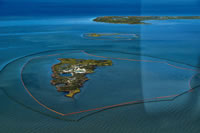 |
| An oil containment boom in the Gulf of Mexico. Photo: U.S. Navy. |
The immediate “react and cure” response included the following:
- g the plant
- urgent assessment of the state of underground storage tanks and the leakage controls on them
- improved environmental and process monitoring to detect leaks and the fate of the releases
- risk assessment of chemical plant operations and new standards for picking sites for new plants
- testing, validatin
The “anticipate and prevent” responses were directed at systemic change. Two examples are Responsible Care and Green Chemistry. Responsible Care was initiated by the Canadian chemical industry in 1985. It is based upon a set of guiding principles and codes of practice and was ultimately adopted by the Canadian industry.
For the Canadian chemical industry: “The codes, like the guiding principles, reflect an ethic, an attitude, a method of thinking about the way in which member companies do business and their role in society. In particular, they address the reality that corporate values must emphasize a long-term commitment to community and occupational health and safety and to environmental protection. Indeed, the codes do not contain static requirements, which, once met, never change. Rather, they necessitate continuous performance improvement in an environment of changing knowledge and regulation. It represents a shift from a legalistic to a moral and ethical way of thinking; from asking, ‘Is it legal?’ To ‘Is it the right thing to do?’”*
This statements has recently been amended to include a reference to serving a larger social purpose—“dedicate ourselves, our technology and our business practices to sustainability—the betterment of society, the environment and the economy.” This includes innovating for safer products that conserve resources and provide enhanced value, and working for the improvement of people’s lives and the environment.
These codes have been adopted by 54 countries to date and other industrial sectors are following suit in ways that make sense to them. By so doing, companies and sectors are committed to continuous improvement and thereby get ahead of their governments’ regulatory agenda. This sort of initiative reflects a symbiotic relationship with government. Enforcement of performance-based government regulations is necessary to deal with free riders and negligent performers and encourage the innovation and creativity that Responsible Care demands. This increases the predictability of behavior by all parties to the benefit of all.
When the pioneers of Green Chemistry propounded the view that chemists were smart enough to displace inherently toxic synthetic chemicals with ones benign to the environment and human health they were probably greeted with derisions. I imagine the response included words like “unrealistic,” “impractical,” or “why bother?” These are common reactions to new ideas put forward by outliers to conventional wisdom. Decades later, Green Chemistry has made important progress. The proliferation of green products in the marketplace is evidence that green chemists are proud holders of a public, or social, license to operate.
The essentials of the BP Macondo catastrophe in the summer of 2010 are well known: 11 deaths, 4.9 million barrels spilled into the most productive fishery in the United States, and intense, prolonged political and media attention at the national, international, and regional level for months.
The immediate “react and cure” agenda inspired by the BP spill in the Gulf of Mexico included the following:
- blow-out preventers that work under all operating conditions
- contingency planning that works efficiently and effectively for all parties
- research into improved oil spill recovery and reduced toxicity of dispersants
- governance—particularly who is in charge, when, and where?
In the long term, there were likely be two systemic shifts: one in risk assessment and management, and the other in the area of governance.
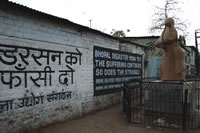 |
| The memorial for victims of the Bhopal Gas Disaster, situated near the former Union Carbide Factory. Photo: Luca Frediani. |
Risk Assessment and Management will be reformed. Currently, most risks are assessed on the basis of individual projects through established processes like environmental or commercial risk assessments. Whenever something goes badly wrong, more complete answers seem only to come from specially commissioned comprehensive inquiries that demand information on strategic considerations like corporate culture and integrity of governance systems.
Three categories of risk management are warranted. The first is Enterprise Risk Management, which is the application of risk assessment to the three operating licenses noted above brought to the level of the enterprise in its entirety through the lifecycle of its activities and integrated across all operations.
The second is Sector Risk Management: The sector—especially for those involved with fossil carbon—needs to look across similar enterprises and consider risk beyond immediate corporate responsibility. The weakest-link theory makes this an exercise in self-interest for all players in a
sector.
The third category of risk management is Technology Assessment: Special consideration is required for the assessment of new technologies or the novel application of existing technologies, as was the case with BP. Because the technologies are new there will be little operating experience and “conventional wisdom” will be mostly in the hands of those commercializing the technology. Their self-interest in rapid deployment is evident and government is frequently hamstrung because it will have both limited knowledge and access to expertise and qualified staff. Nonetheless, whatever is known, regardless of origin, will be used in a government decision to award a government license to operate.
If enlightenment prevails, all parties will acknowledge that more information is required and will demand a more rigorous performance-monitoring regime and a targeted research program to provide the knowledge that is not known, but believed to be important. Things that we don’t know we don’t know are a particular risk with assessing new technologies and the potential for encountering a “black swan”—an impossibility according to conventional wisdom of the 1800s—looms largest. Resource exploitation in ever-more-extreme conditions will elevate this concern.
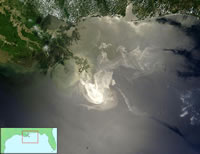 |
| A satellite image of the Deepwater Horizon oil spill taken on 24 May 2010. Photo: NASA. |
The BP spill illustrates that we have to scale-up the governance of risk in a way commensurate with the scale-up that is taking place in industry. This does not need to automatically lead to an increase in cost or paper burdens to industry. Recent moves by industry and government have been to seek relief from the burdens of project-level assessments on the grounds that they inhibit the speed of development. If the above trio of risk assessments at the enterprise, sector, and technology level were undertaken, then there would be a basis for claiming that the demands of project-level assessment could be modified. In their absence there is little to justify it.
The scale-up in operations and oversight results in the need to review governance, a challenge shared by all parties. Every crisis seems to pose new questions about who is in charge, who is accountable for what, and up to what amount. The USD 20 billion reparation fund that BP has placed in trust effectively eliminates previous “ceilings for liabilities” set by government. Previously, liabilities were constrained to relatively modest amounts, meaning the taxpayer was on the hook for the rest.
It is hardly surprising that “lessons to learn from BP” has become a standard agenda item for boards of directors at institutions in all fields, both private and public. Some will want to see worst-case scenarios, while others will see business opportunities. Every aspiring and current CEO will want to avoid the fate of BP’s Tony Hayward. It is less clear that government officials, policy-makers, and regulators have reacted at the same speed.
This a new world that is being haltingly revealed and it will require a serious, objective, nonpartisan discussion engaging our best minds to think this through. Universities as institutions are nonpartisan, independent, and used to handling new ideas. Perhaps they could be invoked to provide a safe haven for all parties to engage in locating solutions rather than just the documentation of positions by vested interests, which seems to be the fate of most consultations.
*Paper based on a presentation made at the 3rd IUPAC Conference on Green Chemistry, 15–19 August 2010, Ottawa, Canada.
*From A History of Responsible Care produced by the Chemical Industry Association of Canada
Robert Slater <[email protected]> lectures in environmental and sustainable development policy from the practical experience of over 30 years as a senior manager of environmental issues for the Government of Canada and in his current position as president of an international consulting practice. He obtained his degrees from Imperial College and is a senior fellow at the International Institute for Sustainable Development. Currently, he is the executive director for Carleton University’s Regulatory Governance Initiative.
Page
last modified 17 May 2011.
Copyright © 2003-2011 International Union of Pure and Applied Chemistry.
Questions regarding the website, please contact [email protected] |